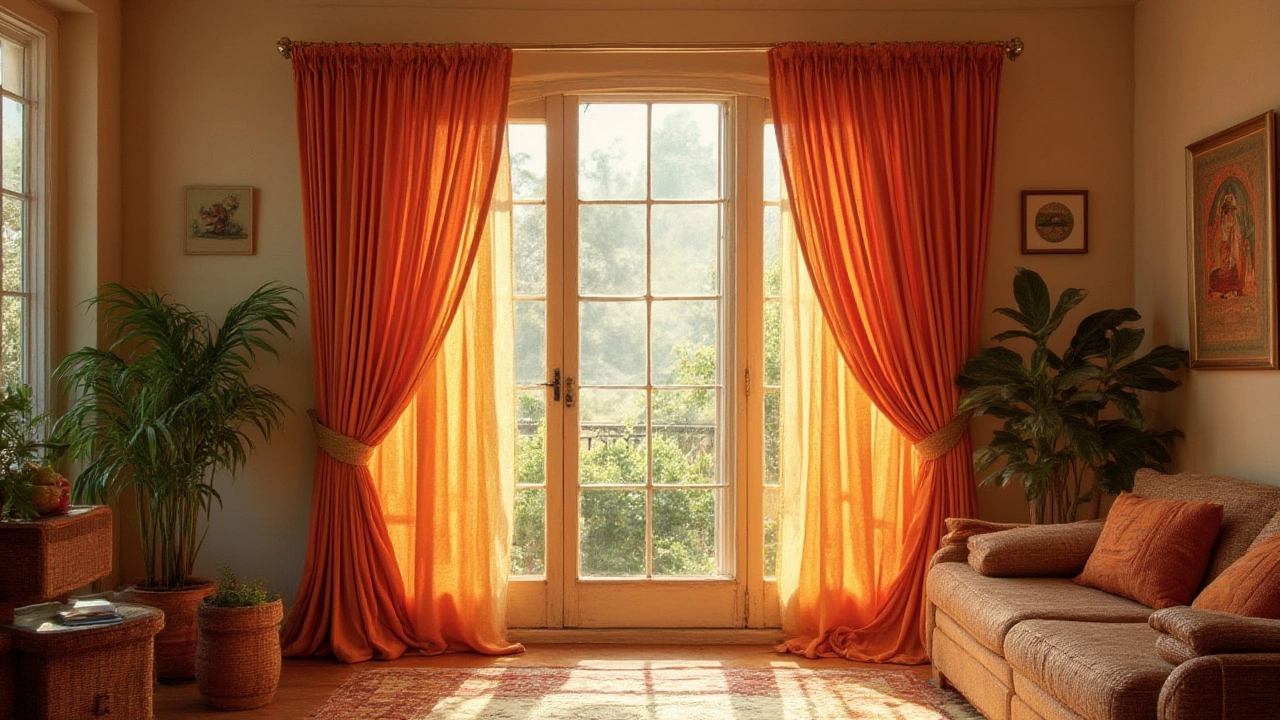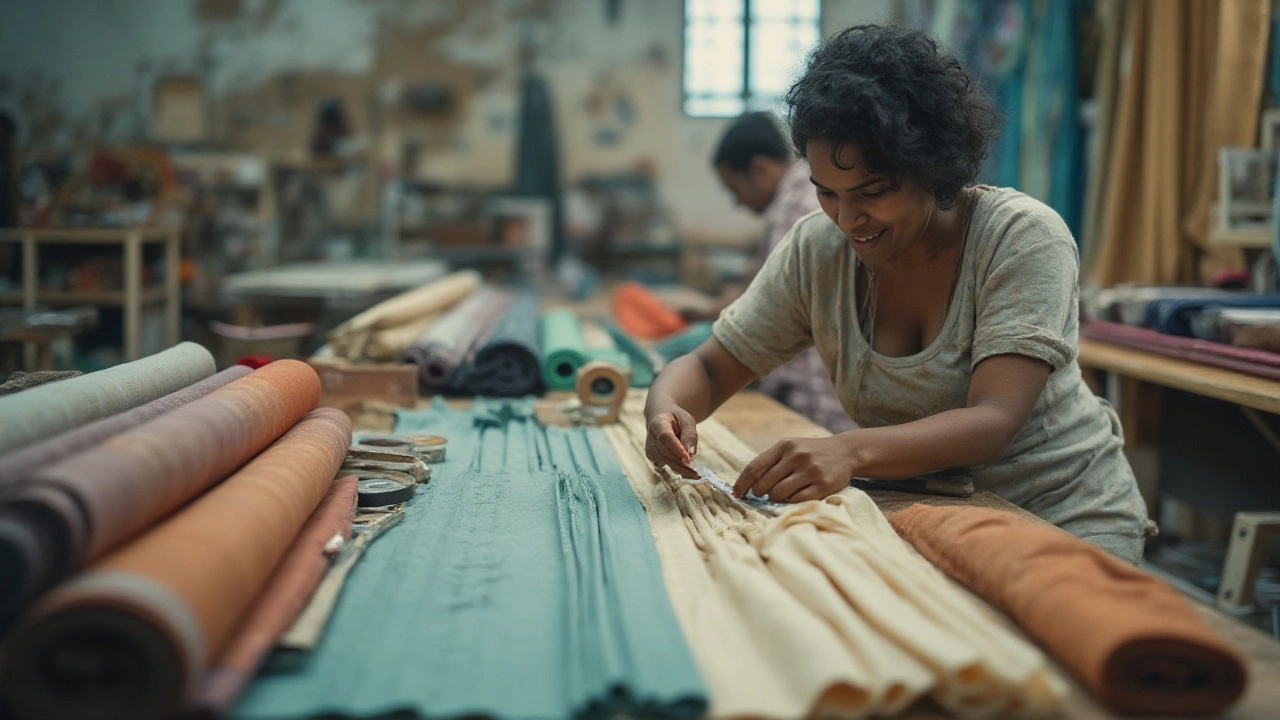What Does Three Bands Mean? The Secret to Choosing Curtains Like a Pro

Ever been stumped by curtain jargon while shopping or browsing how-to guides? You’re not alone. Walk past any curtain display in a Manchester shop, and you’ll spot tags boasting “three bands,” but what’s that actually about? Most of us take curtains for granted—just something you fling open or shut every day. But the ‘three bands’ phrase holds the key to making your living room look posh, homely, or somewhere in between. Let’s get under the fabric and see why these three little bands matter more than you think.
Decoding the Curtain Code: What Does "Three Bands" Actually Mean?
“Three bands” might sound mysterious, but it’s surprisingly down-to-earth. In curtain-speak, it’s all about header tape—the special strip sewn along the top of the curtain, hidden behind the main fabric. This tape gives structure, and it’s what you attach the hooks to, letting you hang curtains in neat, even pleats. The “three bands” refer to three parallel rows or channels on that tape, usually spaced horizontally across the top edge. Each band (or channel) allows you to insert hooks at different heights. This flexibility means you can decide precisely how the curtain hangs, adjusting the height and the style of the pleats. When you flip the curtain over and look at the back, you’ll spot these stitched bands pretty easily—they’re hard to miss once you’re looking for them. Some tapes come with two bands, some four, but three is the Goldilocks standard in UK homes: not too fussy, not dead plain.
Why would you care about the number of bands? Because it changes everything about how your curtains look and feel. Pick a higher band, and your curtain sits closer to the rail—tidy and tailored. Choose a lower band, and it droops a bit, giving a softer, more casual appearance. If you want your room to look a bit more grand—think hotel chic—you’ll want those neat, structured pleats you only get with the right band.
In the world of curtain headers, there’s a bit of competition. Pencil pleat, triple pinch, goblet? They might sound fancy, but most rely on tape, and three bands is the default for “pencil pleat”—the workhorse that suits just about every British window. Let’s put it visually:
| Type of Header Tape | Bands/Channels | Common Use |
|---|---|---|
| 2 Bands | 2 | Basic pencil or tape pleat (budget) |
| 3 Bands | 3 | Standard pencil pleat (most households) |
| 4 Bands | 4 | Designer pleat, variable drop |
You might see the term “multi-pocket tape” in some online shops, and that just means lots of bands: more pockets, more ways to tweak how your curtains hang.
Why the Number of Bands Really Matters For Your Windows
No one wants to spend money on curtains that look saggy or bunched up. Three-band tape gives you the sweet spot: the right mix of flexibility, neatness, and strength. Here’s how that number can change the look and practicality of your curtain setup:
- Easy Height Adjustment: With three bands, you don't have to stress about nailing the perfect drop on your first go. If your curtain hooks are too high or low, just swap to another channel. It’s like having built-in insurance when your measuring isn’t spot on.
- Neater Pleats: Each band lets you pull the curtain fabric into even, consistent folds. Too few bands, you get floppy looking edges. More bands—things can start looking messy if you’re not careful. Three bands keep things looking crisp but not uptight.
- Better Compatibility: Ever try buying new hooks or hanging curtains on a rail you inherited with your flat? Three bands are pretty much the universal standard. They play well with almost every type of hook, rail, or pole most Brits have at home.
- Room for Experimenting: Want to show off a new pole? Hang your curtain from the highest band for a tailored look. Looking for a plush, heavier drape in the bedroom? Use the lower band and let the fabric pool.
There's a touch of psychology here, too. According to interior design expert Kelly Hoppen, “How your curtains hang can change your perception of ceiling height and room size dramatically.” Pick the right band, and even a boxy Manchester flat can feel open and airy.
It’s not just about looks, either. Those bands help carry the weight of the whole curtain, giving it a more even drape and lessening wear and tear where it meets the hooks. Especially if you’re splashing out on heavier fabrics—velvet, lined linen, or blackout—you’ll thank yourself for the extra support the three-band tape gives.
So, next time you’re at Dunelm or scrolling John Lewis online, remember: more bands isn’t always better. “Three bands” strikes that sweet balance, and once you know what it means, you’ll start spotting it everywhere.

How to Choose the Right Band For Your Curtains
Standing in the curtain aisle (real life or virtual), do you just guess which band to use? It’s simpler than it sounds. Here’s how people get it wrong: they either dismiss the bands altogether or just think ‘I’ll use whatever the fitter says.’ But with a basic grip on these bands, you can customise how your curtains frame that precious sunlight.
- First: Check the height of your window to the floor or sill. Curtains usually look best when they just skim the floor, especially for living rooms. Bedrooms often go heavier and longer for a cosier vibe.
- Second: Look at your curtain rail or pole. Most modern rails allow for enough flexibility to experiment. If you have a pole that’s a bit high, use the lowest tape band—brings your fabric lower, filling the gap.
- Third: Consider the style. High bands suit a formal, almost tailored look and show off fancy pelmets or cornices. Lower bands lean into relaxed, country cottage chic.
- Fourth: Think about the usage. Curtains you open and shut a lot (kitchen, lounge), need more strength and should sit securely, so the middle band is usually the winner. Bedrooms—maybe you’re after a slow, graceful drop, so the bottom band’s your friend.
Here’s a walkthrough:
- Lay your curtain flat and find the tape stitched along the top. The bands will run horizontally, like lines on an exercise book.
- Pick your desired drop and decide which band matches up best with your rail or pole height.
- Slide the curtain hooks into the pockets in your chosen band—start in one spot, then skip a few, so the curtain gathers evenly. (Pro tip: count the spaces so your pleats are nice and uniform.)
- Hang your curtain and tweak the hooks as needed—don’t be shy about moving them up or down a band if it doesn’t look right the first time.
A typical mistake? Only using the topmost band, which can leave a gap between curtain and rail—or using the lowest when you want a crisp, structured line. Play around—you might be surprised what a difference it makes to the feel of the room.
“The difference between amateur and pro curtain styling comes down to the choice of header tape and band placement,” shares Kate Watson-Smyth, author of ‘Mad About the House’ and columnist at The Financial Times Home. “It’s all about tiny tweaks that change the energy of a whole space.”
Insider Tips, Common Mistakes, and Smart Shopping
Let’s talk about where people trip up, and how you can sidestep those rookie errors when it comes to three bands. It isn’t just a trip to the shop and picking the prettiest colour. You’re working with three moving parts: the tape, the hooks, and the rail. Skip one detail, and suddenly your new curtains are drooping, uneven, or gappy.
- Don’t ignore the type of fabric. Heavy fabrics need extra support—a good three-band tape helps spread out the weight so you don’t get sagging. If you’ve got sheers or light cotton, you can technically use two bands, but why limit your options?
- Count your hooks. Lay them out along the curtain before you hang. Nothing’s more annoying than discovering you need three extra hooks when you’re halfway up a step ladder.
- Match hooks and tape. Not every hook fits every band. Standard plastic or metal curtain hooks are most common, but double check the width before you get creative with vintage tapes or rails.
- Spacing is key. It’s easy to fudge the pleat spacing and end up with one fat bunch at the end. Use a tape measure and a bit of patience—moving hooks on three bands is a lot easier than you think.
- Three bands is a British classic for a reason. Trends come and go, but this one sticks. Spend the little extra to get proper three-band tape on custom curtains, especially if you’re after that “magazine home” look.
- Wash before you hem. Especially with natural fabrics, give them a wash to let any shrinking happen before you sew up the hems—or those bands won’t matter, your drop will be off.
- Check the return policy. There’s no shame in bringing home a few ‘dummy’ curtains and testing which band looks best on your actual rail or pole. It beats living with a look you hate. Shops like John Lewis and Next are friendly about returns if the label’s still on.
One more insider stat for you: According to a 2024 survey by the Curtain & Blind Makers Association, 81% of British homeowners said their satisfaction with curtains depended most on “the way they hang”—not colour, fabric, or pattern. Headlines might change, but the basics matter most.
Next time you hear “three bands,” remember it isn’t just a throwaway label, but a tiny, important decision that shapes how every room looks and feels. So, give your window a second glance, check its curtain tape, and see how three bands could be the magic touch your home’s been missing.